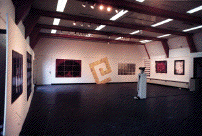
The project for the Communal Gallery in Frankfurt am Main is radical in its impenetrability, because the viewer is shutout from the exhibition space completely. The gallery was particularly appropriate for the idea, as it is one large room that can be entered only through a single double glass door. For this installation, the paintings were hung in the large room and it was closed off.
It was possible to view the paintings through the use of two monitors which were placed on bases in front of the door. On one of the monitors a documentary video of the paintings could be seen. The other monitor was connected to a video camera which was set up on a tripod in the middle of the exhibition. This camera could be operated by a remote control which was built into the base of the second monitor. By pressing the buttons that were built into the base one could tilt, pan or zoom the camera. This construction allowed one to see the exhibited works through the electronic eye of the camera. The zoom on the camera allowed the viewer to also see details of the paintings.
 |
 |
 |
A situation of space and time displacement was created by the two different presentations on the two monitors. One monitor was the displacement of real and virtual space, on the other there was the displacement of time. A present that one was not allowed to actually experience and a prepared past were the two "doors" one could use to enter this exhibition.
(Frankfurt 1991)
// Alba D'Urbano
//

Main;
Archive() {
Esposizione Impraticabile() {
}
Mare();
The Negated Room();
Hautnah;
Touch Me;
Stoffwechsel;
Il Sarto Immortale();
Net-Works();
History();
Imprint;